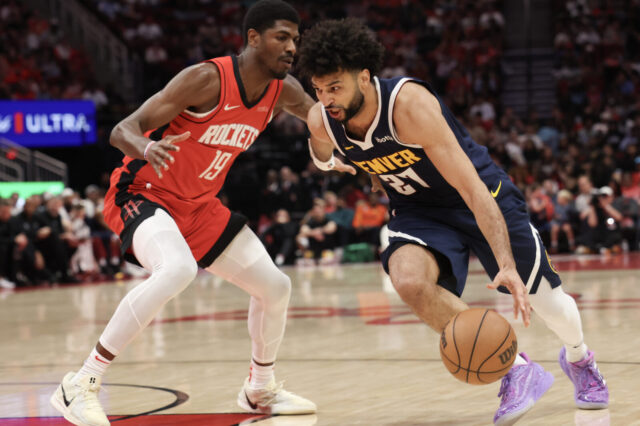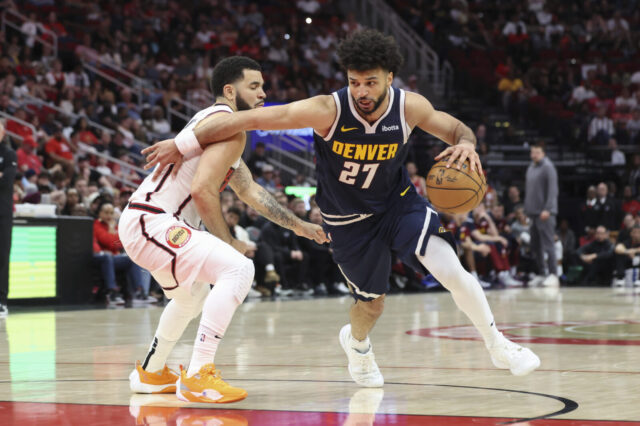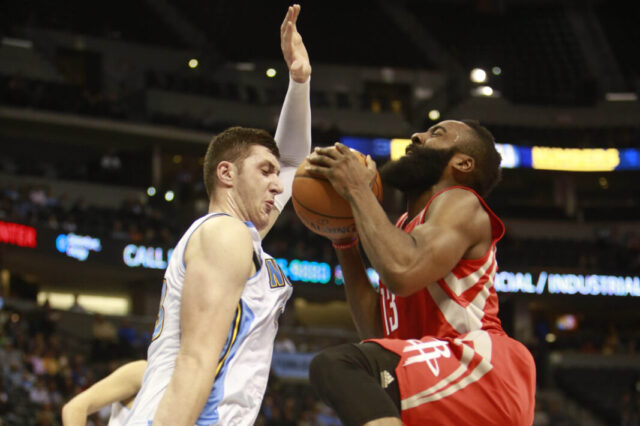Heading up to the NBA Draft, the official kickoff of the offseason, we have analyzed the work of George Karl and the entire Nuggets roster. Now we need to look at the organization as a whole.
What I want to focus on is the overall philosophy the organization has as to how basketball should be played in
The Rockies are a separate animal because in baseball you cannot physically wear the other team down as you can in football or basketball, but it has been cannon in Denver that due to the thin air other teams will wear down as the contest goes on and then the home team can pound them into submission.
Now this was not just an old wives’ tale. Football and basketball players have for years lamented having to play in
However, in recent years we have seen less and less of that.
The Mile High effect came into being with the Broncos back in the day when playing football was a seasonal job. There were no year round training routines or “voluntary” workouts. Players were in worse shape, not only in the offseason, but also during the season.
Today, (most) players stay in at least preseason shape for much of the year, even in the offseason. No one needs an offseason job anymore as the pay for professional atheltes is reasonable. Their job is to keep in shape and hone their talents year round. Professional sports has transformed into a completely different animal from the time when athletes were left panting on the sidelines at Mile High Stadium or McNichols Arena.
Even with this very sizeable difference in the way athletes train the Broncos and Nuggets still cling to this idea that their opponents will wear down simply due to the altitude. In fact, the Nuggets base how they construct their team on that very assumption.
The question that I have to ask is has that assumption become a faulty one.
To answer that question, let’s look at some data. I have done exhaustive research that would make the top criminal defense attorney envious. What I wanted to determine was if the Nuggets home dominance has been consistent throughout the years or has it waned a little as athletes have dedicated themselves to being in better shape.
In order to quantify whether or not the Nuggets had been slipping at home relative to the 1970’s and 1980’s when they had an advantage simply due to the fact that their opponents were not in tip top shape I decided to compare the Nuggets home winning percentage against their road winning percentage in every season since 1970.
By doing that we can track what seasons the Nuggets held a significant home court advantage and performed exceedingly better there than on the road. If the distribution of the seasons with a large difference between home and road winning percentages is spread consistently throughout all seasons, then there is no reason to worry about the Nuggets losing their home court edge. However, if most of the seasons where the Nuggets had a large difference between their home and road winning percentages are skewed towards the old days I think we have something to worry about.
I rummaged through BasketballReference.com to record the Nuggets home record, overall record and pace factor all the way back to 1970 and ranked all those seasons based on the criteria listed above.
Here is what I found out.
– Out of the top 15 seasons with the largest discrepancy between their home winning percentage and road winning percentage only three occurred after 1990.
– The bottom six seasons with the smallest difference between home winning percentage and road winning percentage all occurred after 1993.
– Of the 35 seasons where pace factor has been calculated the Nuggets were either first or second in pace factor 18 times and in the top five 25 times.
– Those 25 seasons are spread all over the chart from the highest home/road differential (1988 differential of 0.634, number one in pace factor) to the smallest differential (2006 differential of 0.024, number two in pace factor). They can be good or average at home even when they run.
I also ranked each season by home court winning percentage alone and only four of the top 16 seasons (four seasons tied for 13th thus I included all of them) occurred after 1988 and out of the bottom 11 seasons only two occurred before 1990. This can be slightly misleading because most of the quality teams in Nuggets history played before 1988 and that is why I used the difference between home and road winning percentages at first, but it still shows that the Nuggets were best at home in the “seasonal athlete” era.
Now what can we do with that data? I did even more research (if only I had worked so hard in college) and checked the pace factor of every championship team since the 1980 finals. Guess how many teams have been in the top five in the league in pace factor and won an NBA championship?
Exactly one. The 1982
In fact out of those 28 championship teams only four of them were in single digits in pace factor. Twenty-one of the 28 were actually in the bottom half of the league in pace factor.
Due to the evidence we have that players are in better shape today, the fact that the most extreme home court advantages for Denver largely occurred before 1990 and the complete absence of running teams in the annals of the NBA that have won championships don’t we have to sit back and question whether or not it is intelligent for the Nuggets to keep pushing the run-the-opponent-out-of-the-gym philosophy.
I hate to be the bearer of bad news
The same thing goes for the Nuggets. The gimmick is over. If the Nuggets want to become an elite team, they better learn to focus on defense and shooting. Just look at the teams that have won the title over the past twenty years. Teams like the Pistons, Bulls, Rockets, Spurs and now the Celtics have had elite defenses. Even the Shaq/Kobe Lakers were a very good defensive team. They have also been teams that have several players that can step out and hit the three or mid range perimeter jump shots.
It will certainly be difficult to convince a city that the identity they have clung to for 40 years is no longer applicable, but hopefully the Nuggets brass will be able to see the writing on the wall. As fun as it is to see them run the Sonics off the court and put up 168 points pales in comparison to the annoying cycle of first round exits we have been experiencing.
They have a few players that can fit that mold. Nene, Kenyon Martin and Marcus Camby have the makings of being a very good interior defense. Melo has the ability to defend, he just has to commit to doing it. Same with J.R. Smith, he can be an above average defender if he will put in the time to learn how to do it. They have a decent foundation. As far as shooters go, well the cupboard is almost empty.
What is important is they have a shot at remaking their roster significantly over the next two to three seasons, starting on draft night. Shred the run and gun blueprint. It has not worked at all over the past 20 years.


